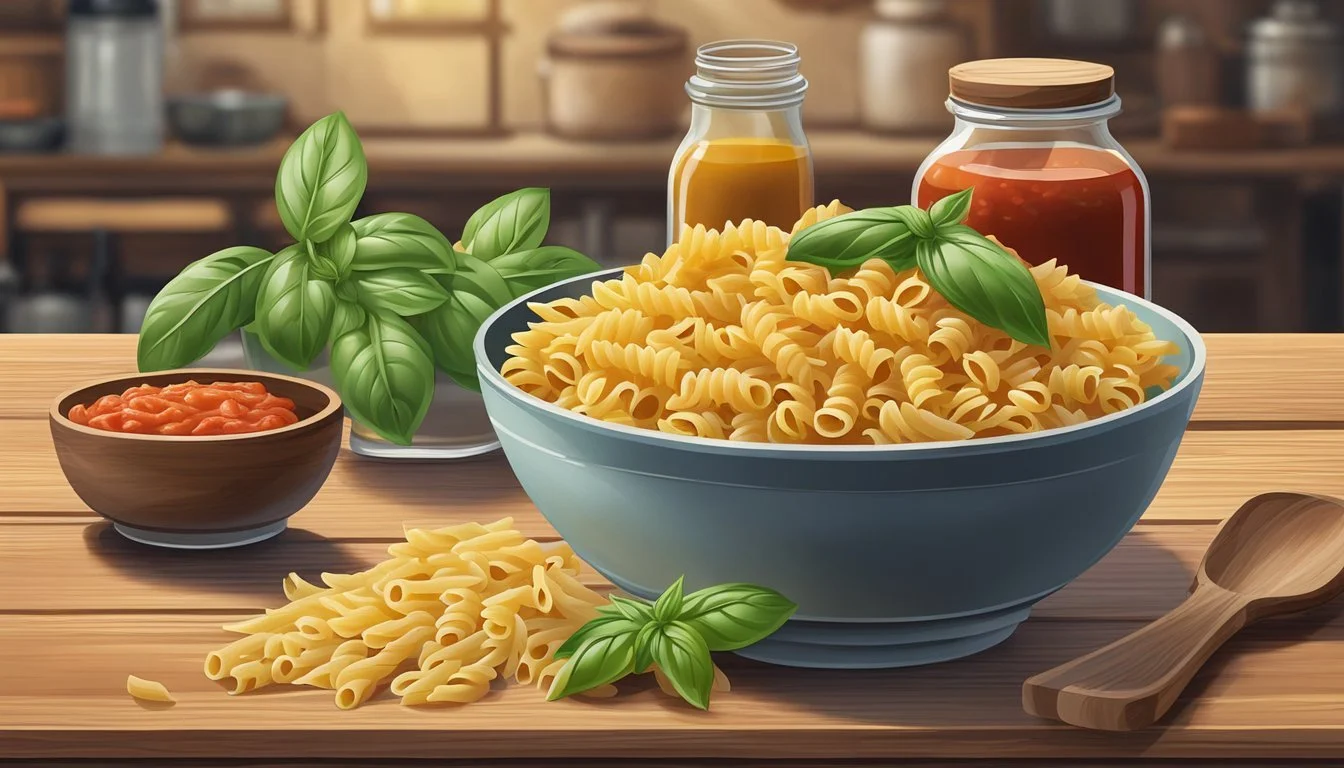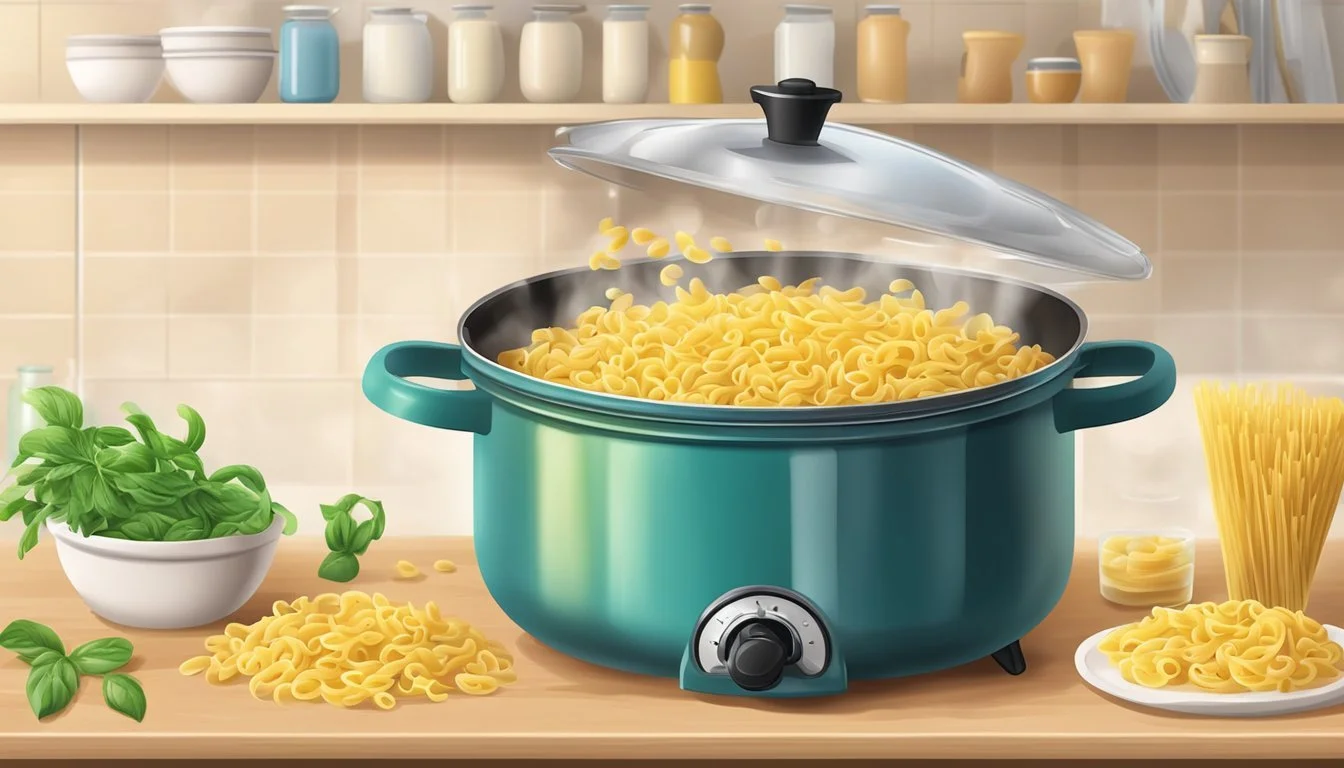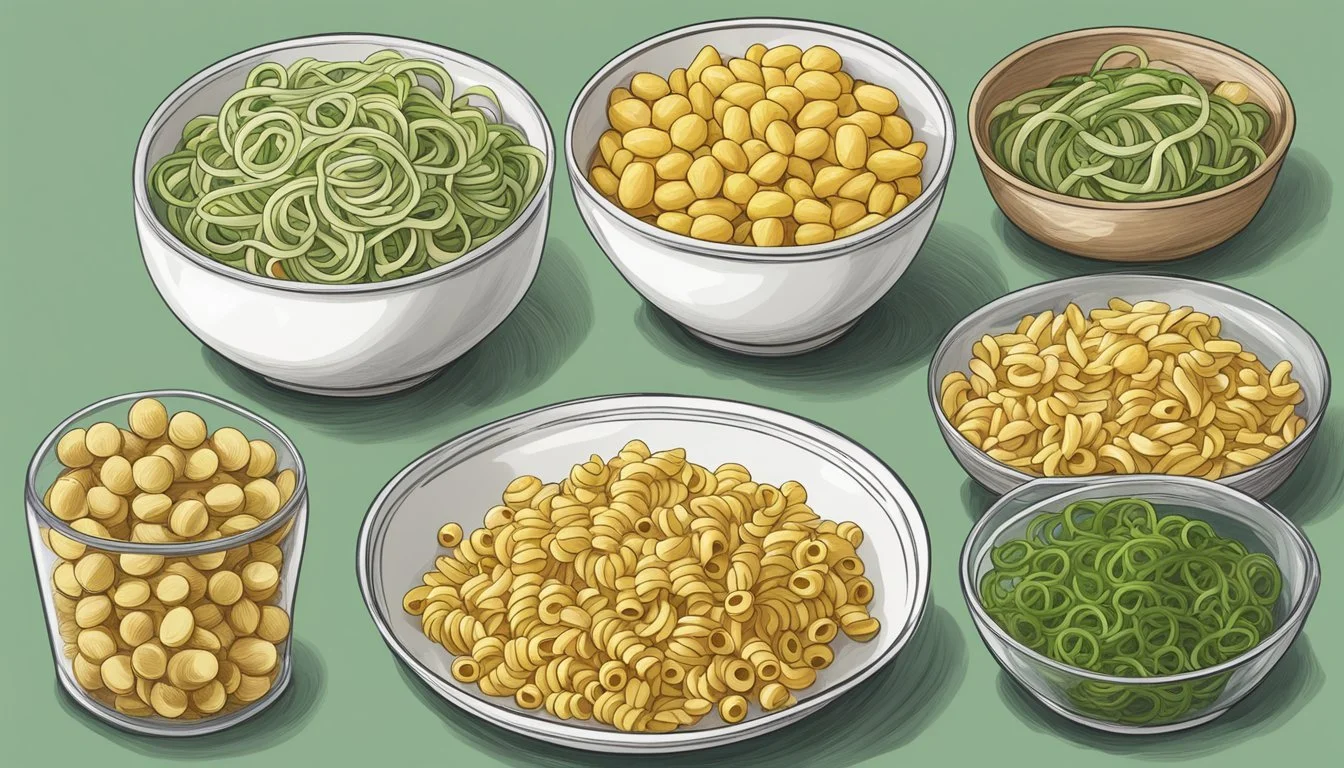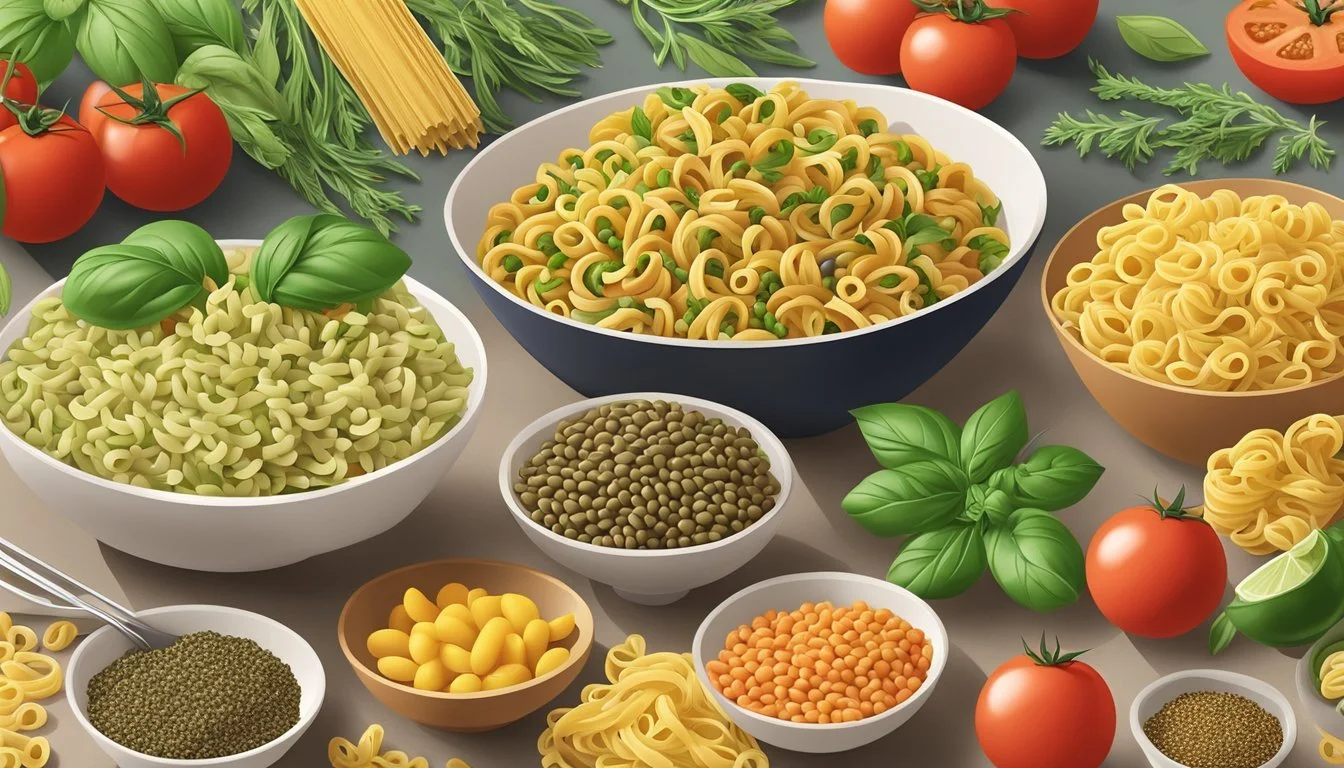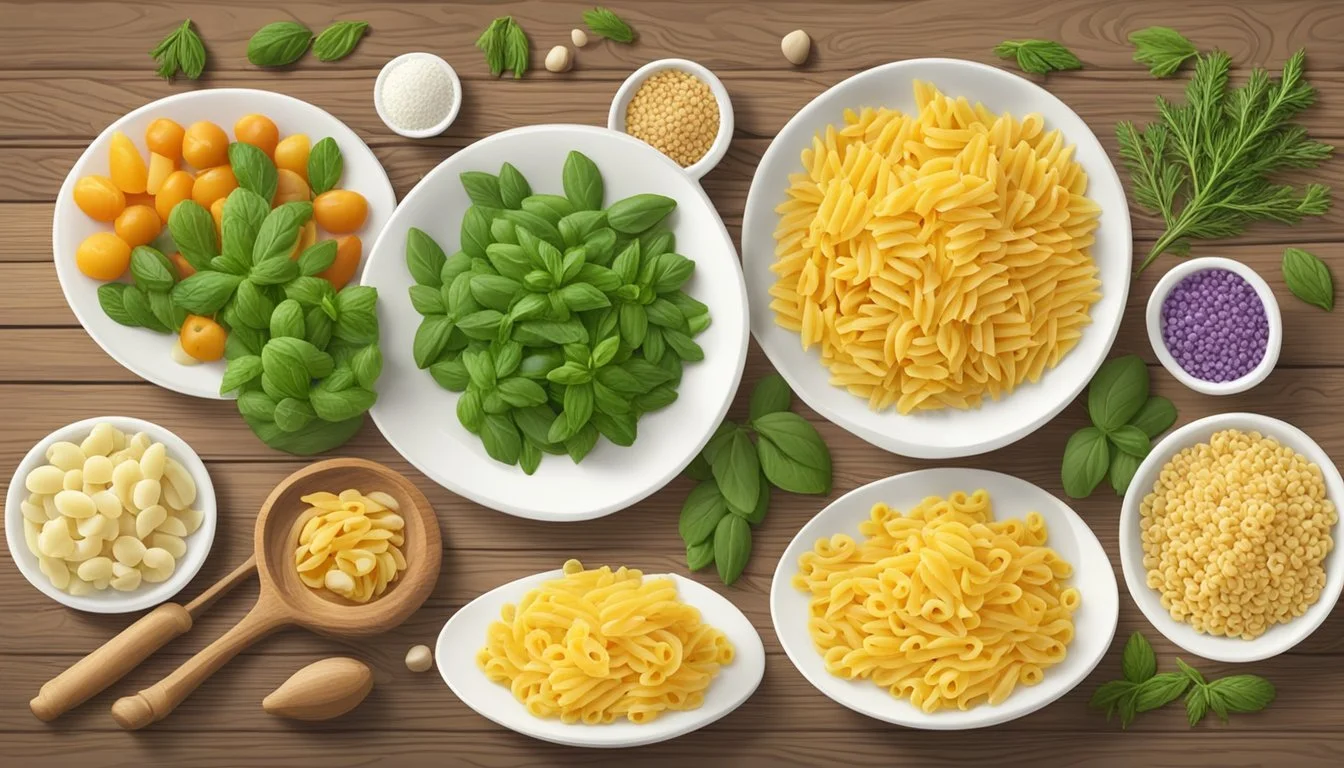Gemelli Pasta Substitutes
Top Alternatives for Your Favorite Twists
Gemelli pasta (What wine goes well with pasta?), a staple in Italian cuisine, is known for its distinctive shape that resembles two strands of pasta twisted together. While this form allows sauces and seasonings to cling effectively, sometimes a home cook may need an alternative. Substitutes for Gemelli may be sought for various reasons, such as dietary restrictions, texture preferences, or simply due to availability.
Many pasta shapes can mimic the functionality and aesthetic of Gemelli in a dish. Some of the substitutes that can be considered include Fusilli and Rotini, both of which have spiral designs adept at holding onto sauces. For those looking for a healthier option, whole wheat pasta and quinoa pasta offer high protein and gluten-free alternatives without compromising on the ability to deliver a satisfying meal.
Each substitute brings a unique texture and flavor profile to the table, expanding the versatility of familiar recipes. When selecting a Gemelli pasta substitute, consider the sauce and ingredients to ensure compatibility and maintain the integrity of the dish. Whether it’s for a pasta salad or a hearty casserole, the right alternative to Gemelli pasta can keep the essence of Italian cooking alive in both tradition and innovation.
Understanding Gemelli Pasta
Gemelli is a fascinating shape within the vast world of pasta varieties. Its name translates from Italian as "twins," due to its configuration which appears as two strands of pasta twisted together into a spiral form. Despite this, each gemelli is actually a single piece of pasta. Its shape is not only aesthetically pleasing but also functional, as it adeptly clings to sauces, augmenting the flavor of a dish.
The texture of gemelli pasta is conducive to a variety of culinary applications; this adaptable pasta can be served in a plethora of dishes, ranging from pasta salads (What wine goes well with salads?) to heartier, sauce-heavy meals. It's traditionally made using durum wheat semolina, contributing to its firm texture and an ability to maintain its shape during the cooking process.
In terms of its regional roots, gemelli pasta hails from Southern Italy. It has garnered popularity for its distinctive appearance, a twist that not only holds sauces effectively but also enriches the dining experience with an engaging mouthfeel.
When considering gemelli, its key characteristics are:
Shape: Twisted, spiral, resembling two intertwined strands
Texture: Firm and able to hold its integrity in various recipes
Flavor: Neutral, making it versatile and accommodating to a broad spectrum of ingredients
While being an Italian staple, gemelli pasta's qualities make it a preferred choice across the globe, embodying the essence of Italian cuisine while offering an inviting foundation for a multitude of flavors and textures.
Reasons for Substituting Gemelli Pasta
Substituting Gemelli pasta is often considered due to several factors such as dietary restrictions, seeking different flavor profiles, or simply because of unavailability.
For those with specific dietary needs, alternatives like whole wheat pasta provide added nutritional benefits with their higher fiber content. Quinoa pasta serves as an excellent substitute for individuals requiring gluten-free options, and it offers a higher protein content with a slightly nutty flavor.
The texture and flavor of a dish can be influenced by changing the pasta type. Substitutes like Rotelle might be chosen for their unique shape which holds onto sauces well, offering a different mouthfeel, while Fusilli or Rotini are favorable for their versatility in various recipes, including pasta salads due to their corkscrew shape.
When Gemelli pasta isn't available in stores, finding a pasta with a similar ability to cling to sauces or achieve the desired cooking time is crucial. Kitchen creativity might lead one to select pasta shapes that are readily on hand, matching the cooking properties of Gemelli as closely as possible.
Substitute Texture Flavor Profile Cooking Time Dietary Note Whole Wheat Denser, Grainier Nutty, Earthy Similar Higher in Fiber Quinoa Firmer Slightly Nutty May Vary Gluten-free, High Protein Rotelle Unique, catches sauces Neutral, Adaptable Similar Great for Pasta Salads Fusilli/Rotini Spiraled, Grips sauces Neutral, Adaptable Similar Versatile Shape
Utilizing these substitutes allows for adjustments according to personal taste, health considerations, and ingredient availability, without compromising on the quality of the final dish.
Selecting the Right Substitute
When choosing the right substitute for Gemelli pasta, one should consider shape and texture, flavor compatibility, and dietary requirements. These factors ensure that the alternative pasta complements the intended dish as closely as possible.
By Shape and Texture
Gemelli pasta is known for its twin spiral shape which allows it to hold onto sauces well. When substituting, one should look for pasta shapes that have similar characteristics.
Fusilli: This corkscrew-shaped pasta is an excellent alternative with its tight spirals, making it adept at trapping sauces.
Rotini: Similar to fusilli but with a slightly tighter spiral, rotini also serves well as a substitute to support hearty dishes.
These two shapes are particularly suitable for pasta salads and robust sauces, given their ability to interlock with and carry flavors.
By Flavor Compatibility
The selected pasta substitute should not only have a similar shape and texture but also a neutral taste that does not conflict with the flavors of the sauce or dish.
Penne: A good substitute due to its tubular shape, it's versatile and does not overwhelm the flavors of the dish it accompanies.
For those interested in health-conscious options, whole wheat variations of these pasta shapes can provide a richer, nuttier flavor as well as added nutritional benefits.
By Dietary Requirements
For those with specific dietary needs, it is important to find a pasta substitute that aligns with their requirements without sacrificing the integrity of the dish.
Whole Wheat Pasta: This pasta is a robust alternative for those looking for more fiber and protein in their meals.
Gluten-Free Options: Included in this category are pasta made from quinoa flour, which is not only gluten-free but also high in protein.
For vegetarians, most classic pasta shapes, including fusilli and rotini, are inherently suitable as they are typically made from semolina flour and water. However, it is always wise to confirm that the selected brand does not include additional non-vegetarian ingredients.
Common Pasta Substitutes
When looking for alternatives to Gemelli pasta, one might consider various pasta shapes that can similarly capture sauces and complement the flavors of different dishes. These substitutes can be whole wheat or gluten-free to accommodate dietary needs.
Fusilli and Rotini
Fusilli is a corkscrew-shaped pasta that is versatile and often used in pasta salads. Rotini, similar in spiral shape to fusilli, is also an excellent substitute, particularly since its spirals are adept at holding sauces, making it suitable for a variety of pasta dishes (What wine goes well with pasta dishes?).
Penne and Ziti
Penne, characterized by its tube-like shape with angled ends, is ideal for most sauces, including chunky meat or vegetable-based sauces. Ziti, a smooth-surfaced, medium-sized tube pasta, pairs well with lighter sauces and is a classic choice for baked pasta dishes.
Macaroni and Cavatappi
Macaroni, a small, elbow-shaped pasta, is a staple in creamy baked dishes such as mac and cheese. Cavatappi is a larger, spiral tube-shaped pasta that is excellent for heartier sauces and perfect for capturing small vegetables and chunks of meat.
Farfalle and Bow Tie
Farfalle, often referred to as "bow tie" pasta due to its shape, is another suitable substitute. Its pinched middle is excellent for lighter sauces and is a popular choice for cold pasta salads.
Alternative Whole Wheat and Gluten-Free Options
For those seeking healthier or dietary-specific substitutes, whole wheat pasta offers a fiber-rich alternative with a nuttier flavor. Gluten-free options, such as those made from rice or corn flour, also provide a variety of shapes and sizes to replace Gemelli without compromising on taste or texture.
Cooking Substitutes for Gemelli
When opting for substitutes for Gemelli pasta, it's crucial to consider variations in cooking times and how these shapes integrate with different sauces and ingredients. Let's explore these adaptations.
Adjusting Cooking Times
Cooking times for pasta substitutes like Fusilli or Rotini may differ slightly from Gemelli. One should always refer to the package instructions for the best results. Typically, smaller or thinner pasta shapes require shorter cooking times, while denser, thicker varieties need to be cooked longer to achieve the desired al dente texture.
Incorporating Creamy and Tomato-Based Sauces
Substitute pastas absorb sauces differently. For creamy sauces, thicker pastas tend to match well, as they provide a generous surface area to capture the sauce. Cream sauces should be allowed to thicken slightly before tossing with the pasta. For tomato-based sauces, the pasta's ridges or corkscrew shapes—much like with Fusilli or Rotini—are excellent at holding onto the vibrant, acidic notes of the tomato.
Pairing with Vegetables and Meats
Gemelli pasta pairs well with a variety of ingredients from vegetables to meats. Pasta shapes like Rotelle can be substituted to maintain visual interest and textural contrast, especially in pasta salads where diverse textures are appreciated. Sautéed vegetables, chicken, sausage, or seafood complement these pastas by nestling into their grooves and curves, ensuring a flavorful bite every time.
Recipe Adaptations With Pasta Substitutes
When incorporating pasta substitutes into recipes, it is important to choose an alternative that complements the texture and flavor profile of the dish, whether it's for salads, soups (What wine goes well with soups?), or baked dishes.
Salads and Soups
For salads, pasta shapes like rotelle and fusilli are excellent alternatives to gemelli. Their intricate shapes are not only aesthetically pleasing but also effective at trapping dressings and small ingredients, making every bite flavorful. In soups, substituting gemelli with pasta like rotini ensures that the pasta holds up well in broth without becoming mushy, and its spirals are known for conveying the soup's full-bodied flavors.
Pasta Salad: Rotelle or fusilli, light vinaigrette or creamy dressing, a selection of fresh vegetables, herbs, and an optional protein like grilled chicken or chickpeas.
Minestrone Soup: Rotini, rich tomato or chicken broth, a mix of vegetables such as carrots, celery, and zucchini, with beans or lentils for added protein.
Pasta Salad Staples
Key to a successful pasta salad is not only the dressing but also the pasta's ability to maintain its texture and soak up flavors. The following substitutes stand out:
Rotini: With its corkscrew shape, it's versatile and able to latch onto both light and heavy dressings.
Fusilli: Similar in form to rotini, these helical shapes are well-suited for holding chunkier ingredients, making them a firm favorite for pasta salad recipes.
Instructions for pasta salad usually involve cooking the pasta al dente, mixing it with a range of dressings and other salad ingredients, and often chilling it before serving to enhance the flavors.
Ingredient Dressing Type Mix-ins Notes Rotini Creamy Olives Ideal for robust salads Fusilli Oil-based Tomatoes Perfect for lighter salads
Baked Pasta Dishes
When it comes to baked dishes like lasagna, substitutes need to maintain their shape and texture in the presence of cream, bolognese, or alfredo sauces. Thick, ribbed pastas are preferable as they hold sauces well under heat.
Baked Ziti: Replace gemelli with ziti or penne. Layer the pasta with ricotta, mozzarella, and a hearty meat sauce for a classic comfort dish.
Macaroni and Cheese: Use elbow macaroni as a substitute. Its hollow shape encapsulates the creamy cheese sauce, ensuring richness in every bite.
In baked dishes, cooking the pasta al dente prior to baking is critical, as it will continue cooking in the oven. This prevents the pasta from becoming overcooked and mushy.
Ingredients and Sauce Pairings for Pasta Substitutes
When exploring pasta substitutes for Gemelli pasta, it is crucial to consider how the shapes and textures of alternative pasta interact with various sauces and ingredients. Pairing the right sauce and fresh components can elevate a simple dish into a satisfying and harmonious meal.
Choosing Complementary Sauces
Pairing sauces with pasta substitutes begins with understanding the surface area and texture of the alternative pasta. For instance:
Rotelle: With its wheel-like shape, rotelle captures hearty sauces well. It's an ideal match for thicker tomato-based sauces that cling to the pasta, ensuring a flavorful bite each time.
Fusilli: This corkscrew-shaped pasta complements creamy sauces due to its twists that trap the sauce. Pesto and light olive oil-based sauces also work well, allowing the sauce to adhere to the pasta's grooves.
Quinoa Pasta: With a firm texture, quinoa pasta can stand up to robust flavors. A protein-rich vegetarian dish often benefits from bold sauces like arrabbiata, enriched with tomatoes and garlic.
Selecting Fresh Ingredients
When incorporating ingredients into pasta dishes, fresh items like seasonal vegetables, fresh herbs, and quality cheeses like parmesan enhance the dish's flavor profile.
Tomatoes and Garlic: These fundamentals pair especially well with lighter pasta like bow-tie (farfalle). They contribute freshness and depth, complementing the pasta's ability to hold sauces.
Parmesan Cheese: Grating parmesan cheese over pasta adds a salty, umami-rich dimension. It's particularly suitable for pasta salads where the cheese can be showcased among a variety of textures.
Seasonal Vegetables: Fresh vegetables like asparagus in spring or butternut squash in autumn can be sautéed with olive oil to augment pasta dishes. These veggies add color, nutrition, and taste, pairing nicely with pasta substitutes like whole wheat or brown rice pasta.
Fresh Herbs: Chopped basil, parsley, or oregano can elevate even the simplest dish. Stirring herbs into tomato-based or creamy sauces adds a burst of freshness that is especially rewarding in vegetarian dishes (What wine goes well with vegetarian dishes?).
Nutritional Considerations
When considering substitutes for Gemelli pasta, it's essential to focus on the nutritional value each alternative brings to the table. Whole wheat pasta stands out as a nutritious option, offering a higher content of fiber and protein compared to traditional white pasta.
For those requiring gluten-free alternatives, quinoa pasta is an excellent substitute. Its composition is rich in protein and contains all nine essential amino acids, making it a robust choice for individuals with gluten intolerances or celiac disease.
Here's a brief nutritional comparison chart:
Substitute Dietary Feature Nutritional Benefit Whole wheat High in fiber & protein Supports digestion, prolonged satiety Quinoa pasta Gluten-free & protein-rich Ideal for gluten intolerance, complete protein source
Vegetarian individuals looking for a Gemelli pasta replacement might gravitate towards these options, given that both are plant-based and align well with a vegetarian diet. It's important for vegetarians to seek varied sources of protein; hence, whole wheat and quinoa pastas are particularly fitting.
In terms of overall health, selecting a pasta substitute doesn't solely hinge on gluten content or vegetarism but on the broader nutritional profile. Diverse pasta alternatives can cater to different health objectives — whether it's increasing the intake of fiber-rich foods or ensuring the consumption of adequate protein within a gluten-free diet. When substituting Gemelli, it's recommended to deliberate on the specific nutritional needs and preferences unique to each diet.
Pasta Substitutes for Special Diets
When considering pasta substitutes for special diets, one must be mindful of ingredients catering to gluten-free, vegetarian, and vegan needs. Whole wheat options may not be suitable for gluten-free diets, while vegetarian and vegan varieties should exclude animal-derived ingredients.
Gluten-Free Options
For individuals with gluten intolerance or celiac disease, quinoa pasta emerges as a robust choice. It's crafted from quinoa flour, offering a high-protein meal with a firm texture and a slightly nutty flavor. Another favored option is rice pasta, which adapts to most pasta dishes seamlessly and is naturally gluten-free.
Vegetarian and Vegan Varieties
Vegetarian and vegan diets can be accommodated with pasta made from vegetables themselves. Spiralized vegetables, such as zucchini or carrots, can be used in place of traditional pastas and are especially delightful when cooked until just tender, making a nutritious and colorful base for a variety of sauces and toppings. For a more traditional pasta experience, look for options like lentil or chickpea pasta, which are both high in protein and free from animal products, aligning with vegetarian and vegan dietary preferences.
Storing and Preparing Substitutes
When opting for substitutes to Gemelli pasta, proper storage and preparation are key to maintaining quality and taste. For dried pasta alternatives such as fusilli, rotini, and rotelle, they should be stored in a cool, dry place in an airtight container to prolong shelf life and prevent moisture absorption. Fresh pasta variants, by contrast, require refrigeration and should be consumed within a few days.
Preparation Instructions:
For dried pasta:
Fill a large pot with water, adding a generous amount of salt.
Bring the water to a rolling boil before adding the pasta.
Stir occasionally to prevent sticking.
Follow the package instructions for cooking times, typically until al dente, which translates to a firm bite.
For fresh pasta alternatives:
Cook for a significantly shorter duration than dried pasta, often just a couple of minutes.
For Pasta Salads:
Substitute pasta like rotelle is ideal as its unique shape allows dressings and ingredients to cling.
Suggested Cooking Times:
Fusilli: 10-12 minutes for al dente texture.
Rotini: Similarly, around 10-12 minutes.
Rotelle: Check at 8 minutes and adjust as needed.
Note: Always taste test a few pieces before draining to ensure the desired texture is reached. To stop the cooking process, drain and rinse with cold water, especially when making pasta salads.
Properly storing and precisely preparing pasta substitutes will ensure that the dish retains optimal flavor and texture, serving as a suitable alternative to Gemelli pasta.
Expert Tips and Tricks
When searching for Gemelli pasta substitutes, one should consider not only the shape but also how the pasta's grooves hold sauces and ingredients. Versatile pasta types like Fusilli and Rotini are excellent choices due to their spiral shapes and surface textures, which are adept at trapping flavorful sauces.
Fusilli: A corkscrew-shaped pasta that clings to sauces well.
Rotini: Similar to Fusilli with a slightly tighter spiral.
When cooking these substitutes, aim for al dente texture to ensure the pasta provides a satisfying bite. The goal is to preserve the pasta's consistency after it soaks up sauces and dressings.
Pasta Type Texture Cost Prep Time Fusilli Holds sauce well Cost-effective Similar to Gemelli Rotini Grips ingredients Affordable Comparable to Gemelli
For flavor enhancement, one can incorporate ingredients that complement the shapes. For instance, Rotelle, also known as wagon wheels, can make a playful addition to pasta salads, where each "wheel" captures chunks of dressing or veggies.
To achieve the best results:
Follow the pasta package's cooking instructions closely.
Cook in salted boiling water to infuse flavor from the start.
Save a cup of pasta water to emulsify and thicken sauces.
When selecting a substitute, a cook should also consider the dish's nature and the cost. Common varieties of pasta like Fusilli and Rotini are budget-friendly and widely available, making them practical for routine cooking while satisfying in diverse culinary contexts.

